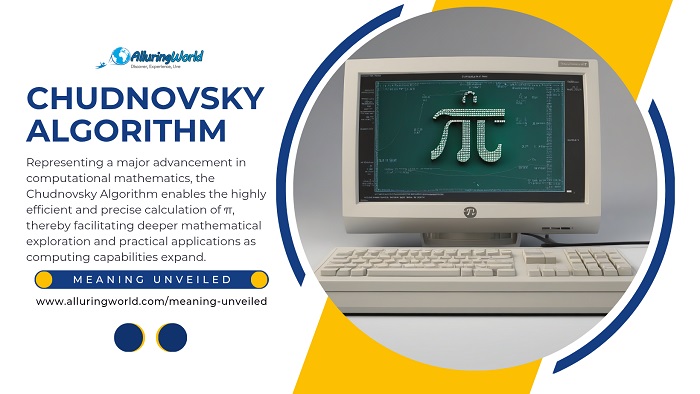Read time ca. 3 minutes
The Chudnovsky algorithm is one of the fastest known methods for computing the digits of π with extreme precision. Developed by mathematician brothers David and Gregory Chudnovsky in 1987, this algorithm is based on Ramanujan-like infinite series and has been instrumental in setting world records for calculating trillions of digits of π, where its speed and efficiency make it a key tool in modern computational mathematics, especially in fields that require high-precision calculations.
Mathematical Foundation:
Imagine you want to find the value of pi (π), that famous number starting with 3.14159… The Chudnovsky algorithm is a super-fast way to do this. It uses a special kind of mathematical recipe called a series, and Chudnovsky algorithm relies on a rapidly converging series derived from modular functions and complex analysis. It is based on the following formula:
1π=12∑k=0∞(−1)k(6k)!(545140134k+13591409)(3k)!(k!)3(640320)3k+3/2\frac{1}{\pi} = 12 \sum_{k=0}^{\infty} \frac{(-1)^k (6k)! (545140134k + 13591409)}{(3k)! (k!)^3 (640320)^{3k+3/2}}
Think of a series like a set of instructions where you keep adding up numbers, and each number in the series gets you a little closer to the exact value of pi. The Chudnovsky algorithm’s series is particularly special because it involves a lot of complicated math terms (like factorials and big numbers), but the key is that each step brings you much closer to the right answer than most other methods.
The formula you see is the actual recipe, and even though it looks intimidating, it’s just a precise way of saying how to calculate each number in the series and add them up. The symbols like ∑ (sigma) mean add up all the following terms. The k represents a counter that goes up by one each time you calculate a new term.
What makes the Chudnovsky algorithm so amazing is how quickly it gets you to the right answer. Converges means how fast the series gets closer and closer to the actual value of pi.
With older methods, you might have to calculate hundreds or thousands of terms to get a few accurate decimal places, but with the Chudnovsky algorithm, each new term you calculate adds about 14 more correct digits to your answer!
This incredible speed makes it perfect for computers trying to calculate pi to millions or even trillions of decimal places, and it’s like having a super-powered shortcut to finding pi, allowing mathematicians and computers to push the boundaries of what we know about this fundamental number.
Efficiency and Speed:
As mentioned above, what sets the Chudnovsky algorithm apart from previous algorithms, such as the Gauss-Legendre algorithm, is its rapid convergence. Previous algorithms take millions of terms to compute a large number of digits, whereas the Chudnovsky series can accomplish the same with far fewer iterations.
This effectiveness has made it the favored method of world-record calculation for levels of π digits. Distributed computing efforts and supercomputers use it in order to extend the frontiers of numerical precision.
Applications and Modern Usage:
The Chudnovsky algorithm is widely used in high-precision calculations where π plays a crucial role, and some key applications include:
- Cryptography: Many encryption algorithms require high-precision calculations of π.
- Scientific Computing: Fields such as astrophysics, quantum mechanics, and engineering simulations benefit from accurate values of π.
- Mathematical Research: Studies in number theory and irrational numbers often rely on precise approximations of π.
In recent years, researchers have used this algorithm to compute over 100 trillion digits of π, demonstrating its power and reliability.
Conclusion:
In conclusion, the Chudnovsky algorithm is a significant breakthrough in computer numerics that offers a supremely efficient solution to calculating π to unprecedented levels of precision. Its rapid convergence has revolutionized the field with its ability to allow mathematicians and scientists to explore deeper mathematical realities and solid applications. Computing power still ascending, this algorithm will continue to be at the forefront of computing π, stretching the boundaries of human knowledge.

